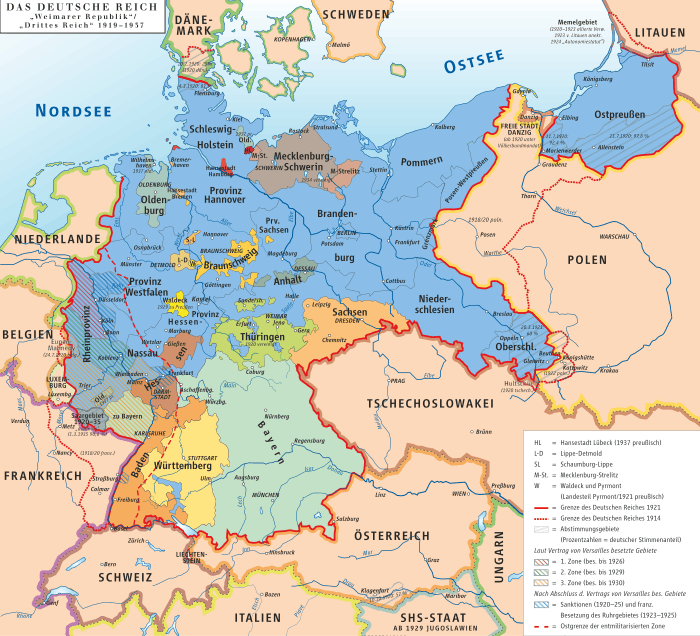Fourth Reich
The Fourth Reich (German: Viertes Reich) is a hypothetical future German Reich that is the successor to Third Reich (1933–1945).
The term "Third Reich" was coined by Arthur Moeller van den Bruck in his 1923 book Das Dritte Reich. He defined the Holy Roman Empire of the German Nation (962–1806) as the First Reich, and the German Empire (1871–1918) as the Second Reich, while the "Third Reich" was an ideal state including all German peoples, including Austria. In the modern context the term refers to Nazi Germany. It was used by the Nazis to legitimize their regime as a successor state to the retroactively-renamed First and Second Reichs.
The term "Fourth Reich" has been used in a variety of different ways. Neo-Nazis have used it to describe their envisioned revival of Nazi Germany, while others have used the term derogatorily, such as conspiracy theorists like Dr. Joseph P. Farrell, Peter Levenda, and Jim Marrs who have used it to refer to what they perceive as a covert continuation of Nazi ideals.
Neo-Nazism

In terms of neo-Nazism, the Fourth Reich is envisioned as featuring Aryan supremacy, anti-Semitism, Lebensraum, aggressive militarism and totalitarianism. Upon the establishment of the Fourth Reich, German neo-Nazis propose that Germany should acquire nuclear weapons and use the threat of their use as a form of nuclear blackmail to re-expand to Germany's former boundaries as of 1937.[1]
Based on pamphlets published by David Myatt in the early 1990s,[2] many neo-Nazis came to believe that the rise of the Fourth Reich in Germany would pave the way for the establishment of the Western Imperium, a pan-Aryan world empire encompassing all land populated by predominantly European-descended peoples (i.e., Europe, Russia, Anglo-America, Australia, South America's Southern Cone, New Zealand, South Africa).[3]
Usage to indicate German influence in the European Union
Commentators throughout Europe have used the term "Fourth Reich" to point at the influence that they believe Germany exerts within the European Union.[4][5][6]
See also
References
- ↑ Schmidt, Michael The New Reich—Violent Extremism in Germany and Beyond, 1993.
- ↑ These writings of Myatt included the 14 pamphlets in his Thormynd Press National-Socialist Series, most of which were republished by Liberty Bell Publications (Reedy, Virginia) in the 1990s, and essays such as Towards Destiny: Creating a New National-Socialist Reich [archived at https://web.archive.org/web/20040712101315/http://www.geocities.com/myattns/newreich.html] and a constitution for the 'fourth Reich' [archived at https://web.archive.org/web/20041208070520/http://www.geocities.com/myattns/cons_reich.html]
- ↑ Goodrick-Clarke, Nicholas Black Sun: Aryan Cults, Esoteric Nazism, and The Politics of Identity New York: 2002--N.Y. University Press, See Chapters 4 and 11 for extensive information about the proposed "Western Imperium"
- ↑ "The Fourth Reich is here - without a shot being fired". The Daily Telegraph. 15 May 2016. Retrieved 2017-02-12.
- ↑ "Merkels Tyskland - Fjärde Riket?" (in Swedish). Retrieved 2017-02-12.
- ↑ "'The Fourth Reich': What Some Europeans See When They Look at Germany - SPIEGEL ONLINE - International". Der Spiegel. Retrieved 2017-02-12.
Bibliography
- Infield, Glenn. Secrets of the SS (Stein and Day, New York, 1981) ISBN 0-8128-2790-2
- Schultz, Sigrid. Germany Will Try It Again (Reynal & Hitchcock, New York, 1944)
- Tetens, T.H. The New Germany and the Old Nazis (Random House, New York, 1961) LCN 61-7240
- Wechsberg, Joseph. The Murderers Among Us: The Simon Wiesenthal Memoirs (Mc Graw Hill, New York, 1967) LCN 67-13204
- Marrs, Jim (2008). The Rise of the Fourth Reich. New York: William Morrow. ISBN 9780061245589.